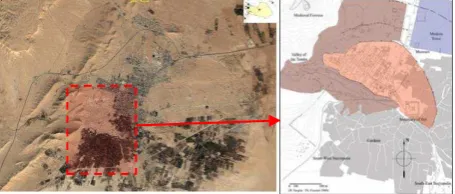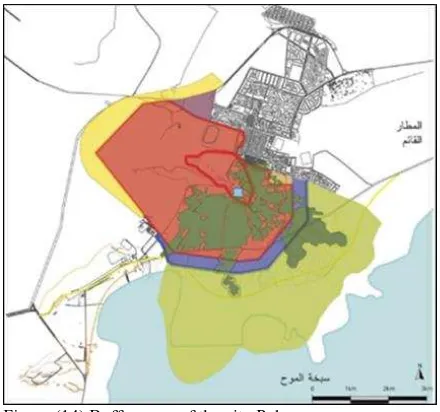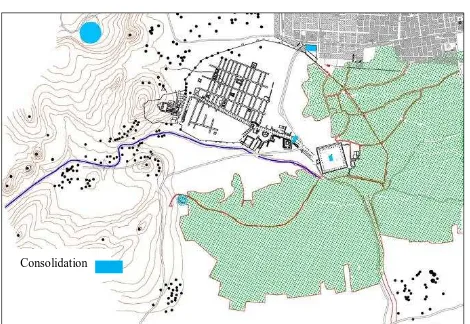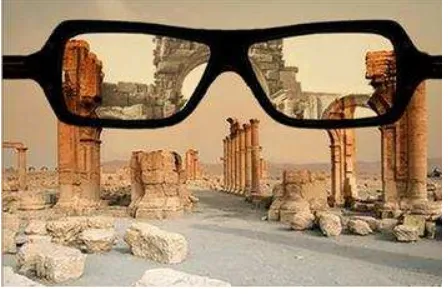TITLE: VISION OF THE RECONSTRUCTION OF DESTRUCTED MONUMENTS OF
PALMYRA (3D) AS A STEP TO REHABILIATE AND PRESERVE THE WHOLESITE
Abir ARKAWI, Professor at the Faculty of Architecture
–
Damascus University, Supervisor of Palmyra
workshop. (200 Students & Master student) Email:
[email protected]
Key words
: Palmyra’s Vision,
classical historical moments, consolidation, reconstruction, rebuild,
restoration, integrated conservation plan
ABSTRACT:
Syria is one of the world’s most impressive Cultural Heritages in terms of the number and historical significance of its monuments. Palmyra lies in the heart of Syria, an oasis in the midst of the arid desert.it could be considered as a part of this human heritage. In1980 was registered on the world and national heritage list for its huge historical importance. In addition, it was the focus of many studies and researches in the fields of restoration. Then the disaster happened, many monuments were demolished, temple of Ba’al, temple of Bael-shameen, Arch of triumph and the Castle. Lately the Tetrapylon and the Stag. Every Syrian was hurt, the whole world was hurt. The destruction of the city caused its people to become homeless and Palmyra was no longer the oasis we know. We felt pain, so we wanted to make a move, a step forward, to present a work that expresses our love for Palmyra, we organized Palmyra workshop to provide a vision for the reconstruction and revival of the historic site importance. Visions with using new idea & new technology. Palmyra historical areas are considered a large open museum for heritage through history, which is the reason to treat these area as a historical protection precinct and give a vision, ideas, suggestions to the future of Palmary as a first step to preserve the historical buildings& the archeological park.
1-INTROUDUCTION:
1-1- Historical Background of Palmyra:
Palmyra isan oasis in the Syrian Desert, northeast of Damascus; it was one of the most important cultural and commercial centers of the ancient world (1). The city grew wealthy from trade caravans; the Palmyrenes were renowned merchants, who established colonies along the Silk Road and operated throughout the Roman Empire.The culture of Palmyra was influenced by Greco-Roman and produced distinctive art and architecture that combined eastern and western with local traditions (2).
Fifure(1)Palmyra befor Destruction
By the third century AD, Palmyra was a prosperous regional center reaching the apex of its power in the 260s, when Palmyrene King Odaenathus defeated Persian Emperor Shapur I. The king was succeeded by regent Queen Zenobia, who rebelled against Rome and established the Palmyrene Empire. In 273, Roman emperor Aurelian destroyed the city, which was later restored by Diocletian at a reduced size( ).The Palmyrenes converted to Christianity during the fourth century and it became the headquarters of the diocese. Muslims came by leader Khaled bin Al-Walid 634 ADS, increasedits importance in the Umayyad era because of its presence between the eastern ( ) .
_______________
( 1 ) 2371-2361 BC:Cuneiform texts of the era of Sargon al – Alkkidi, 1115-1077 BC:Ancient book of the Assyrian king Tlagat Balasar I, 604-562 BC: Campaigns of the Babylonian King Nebuchadnezzar II, 18th century BC:Ancient texts of Mary,336-323 BC: Alexander Macedonian, 323-124 BC: Alsaloqeen After the death of Alexander,70-55 BC:A neutral zone between the
Roman Empire and the Frithian .
In the Ayyubid and Mamluk reigns, the castle was rebuilt, the second fortress Fakher al-Din. In 14th century, Tamerlane destroyed the city and ended its importance. During the Ottomans, the city was neglected and abandoned.
1-2-Discriptions of Palmyra & its Monuments:
Palmyra Houses were settled as they agreed on the spring of Afqa (3) and around the Temple of Ba’al. The people lived in the western part of Palmyra & built with small stones, bricks and mud, but when they flourished in the first three centuries of the birth the population of the city began to grow( ), and most important buildings were built in the city during these three centuries. In20 century the inhabitants were living in the Ba’al Temple and, After their removing in1932, the ancient site was available for excavations and restorations and the modern city begin to developing.
Figure (2-3) Site plan of Palmyra and the modern city GIS/ 2016 & the Site of Palmyra
Palmyra holds the record for the number of rich cultures that could be found in one place. Numerous archaeological missions of various nationalities as well as national missions have been worked in Palmyra ( ).In 2015, Palmyra came under the control of the Islamic State of Iraq and the Levant (ISIL), and subsequently changed hands several times between the militant group and the Syrian Army who retook the city on 2 March 2017. ISIL sabotaged many artifacts and destroyed a number of buildings, considerably damaging the ancient site.
The most important Monements:
with a propylaea, and the cella stood on a podium in the middle of the enclosure.
The Temple of Bael-shameen dates to the late 2nd century BC in its earliest phases; its altar was built in AD 115( ) and it was substantially rebuilt in AD 131.( ) It consisted of a central cella and two colonnaded courtyards north and south of the central structure.( ) A vestibule consisting of six columns preceded the cella which had its side walls decorated with pilasters in Corinthian order.( )
The Temple of Nabu is largely ruined.( ) The temple was
Eastern in its plan; the outer enclosure's propylaea led to a 20 by 9 metres (66 by 30 ft) podium through a portico of which the bases of the columns survives.( ) The peristyle cella opened onto an outdoor altar( )
The Temple of Al-lāt is largely ruined with only a podium, a few columns and the door frame remaining.[38] Inside the compound, a giant lion relief (Lion of Al-lāt) was excavated and in its original form, was a relief protruding from the temple compound's wall.( )
The Tetrapylon was erected during the renovations of
Diocletian at the end of the third century( ) It is a square platform and each corner contains a grouping of four columns.( ) Each column group supports a 150 tons cornice and contains a pedestal in its center that originally carried a statue.( )
The Stag: is a Roman theatre dates back to the second-century
CE Severan period( )The theatre's remains have since been restored. the stage measures 45.5 by 10.5 metres
Figure (4) The main monuments in Palmyra’s site
National Museum: It is located in the new city .It shelters
most interesting archaeological collections from the whole Site. Other: Afqas spring, the Oasis, Temple of Belmonton, and Manna, Crucifixion, Bathrooms, Structure of nymphs, The walls, Camp Dioclesian, Agora, the Castle, Cemeteries: Burial cemeteries, Landfills, Vault-House & Individual Graves Figure( ).
The city was not famous just for its temples but for its cemeteries also. The tombs have a great historic, social and culture values. They divided into four areas outside the city walls: the northern cemetery north of the old city, the western cemetery known as Wadi al-Qabour in the west, the southwest tombs to the south-west, and finally the southeast tombs in the southeast, we introduce 2 examples for tower tombs 2 from 50 tombs:
Figure (5) The cemeteries/wadi al-Qabour
Figure (6) Tower tomb of Ellabell &Tower tomb of Atenatan
Tower tomb of Ellabell: Four stories high about 20 meters high.
The ground floor is colored and its edges are decorated with Corinthian arches set with the statues of the family members Above the door is an engraving of one of the sons of Ellabell, with two poles at the top and three at the bottom
Tower tomb of Atenatan: height of about 12 m. The body
composite tower over the basis is introducing 8.20 m square above the entrance is an engraved inscription engraving the names of the people who were buried in this room: Kohlu and Hiran, children of Attenan and their children.
1-3-2D-
3D DOUMENTATION
:This part will show the work of the students of the vision of
Palmyra’s workshop. All drawings were done in 2 D. 3 D for all the monuments:
Figure(8) Ba’al Temple 2D modelling
Figure(9) The Tetrapylon
Figure (10) Theater Prespective
This part have for evry bulding und monemnt a corounplan – lelevations- sections-prespective ( in 2 condition as orginal when it was build and leter as it was befor the dustructions 3D modelling Perspective
Figure(11) Bael-shameen Temple
Figure (12) Temple of Bael-shameen
2-SITE ASSESSMENTS:
2
-1-Cultural Significance Values:
The UNESCO hasregistered the site as a world heritage sites in 1980. National authorities listed the old walled city early in 1972. One hundred and ten (110) individual monuments were already listed in Palmyra when UNESCO listed the city in 1979. The number of monuments, which were listed until now, is 285 monuments. The Sites Outstanding Values:
Criterion (I): The splendor of the ruins of Palmyra, rising out
of the Syrian Desert northeast of Damascus is testament to the unique aesthetic achievement of a wealthy caravan oasis intermittently under the rule of Rome from the First to the 3rd century AD. The grand colonnade constitutes of a characteristic example of a type of structure, which represents a major artistic development.
Criterion (ii): Recognition of the splendor of the ruins of
Palmyra by travelers in the 17th and 18th centuries, contributed
greatly to the subsequent revival of classical architectural styles and urban design in the West.
Criterion (iv): The grand monumental colonnaded street, open
in the center with covered side passages, and subsidiary cross streets of similar design together with the major public buildings, form an outstanding illustration of architecture and urban layout at the peak of Rome's expansion in and engagement with the East. The great temple of Ba'al is considered one of the most important religious buildings of the 1st century AD in the East and of unique design. The carved sculptural treatment of the monumental archway through which the city is approached from the great temple is an outstanding example of Palmyrene art. The large-scale funerary monuments outside the city walls in the area known as the Valley of the Tombs display distinctive decoration and construction methods.
3-2-legel Assessment
: The UNESCO has registered the siteas a world heritage sites in 1980. National authorities listed the old walled city early in 1972. The Syrian Law of Antiquities (1963) allows for the protection by the General Directorate of Antiquities of individual buildings as well as of ancient quarters. A protection area may be defined around a building or a district. If the protection area were not defined in the time of listing, this could be done later by ministerial decree (article 13). The easements around the site may concern non-aedificandi areas as well as heights, construction materials, techniques and colors and even windows and terraces of buildings (article 14). The Antiquities authorities’ approval is anyway necessary for any building license ( )
Buffer zone: The site was designated as a national monument and is now protected by the National Antiquities law 222 as amended in 1999. A buffer zone was established in 2007.A Diagram shows the Ratifies of the six areas of protection of the minister of culture and the Supreme Council of Antiquities source (the strategic plan of action for the territory of Palmyra MAM).
A actually in the 1920s, during the French mandate was for the first time defining protection zones of the effects of Palmyra and that protect Palmyra for long time .
Figure (14) Buffer zone of the city Palmyra
Protection zones of the effects of Palmyra in 1920
The limits of the protection of the first archaeological site does not allow any type of facilities or infrastructure projects.
The current borders and the archeological site had match the limits by the French in1934 with a simple modification in 1978.
The delimitation of the archaeological site in 1976 as an amendment to the basic borders set by former French in 1934, and issued Resolution No. 38 in January 2008 after the approval of the DGAM and ratified by the minister of culture puts the border for six areas of the protection of the archaeological site of the Registrar takes in.
The limits of the protection of the first archaeological site does not allow any type of facilities or infrastructure projects.
Start from the southern border of the archaeological site and continues toward the oasis after 250 m, does not allow any type of construction, but allows for some simple cross infrastructure in the region on numerous occasions, water and sewage, roads and others paved roads according to the need.
Include the limits of barrenness (Salt Lake), which is located between the southern and south-eastern part of the protection zone is composed of agricultural land, which should be the protection of the quality of the land and do not allow the establishments by the laws of the land itself. Allow environmental installations, which are in line with the historic and natural features of the site, but that the License requires the approval of the ministry of culture and the DGAM.
This region does not permit any type of construction Building Area no later than 5m altitudes (environmental architecture. one floor) commensurate with the surrounding environment. An essential condition.
Figure (15) Protection zone near the Castle
The tower hill near the castle which is reflected negatively on the natural scene the landing during the terrorist attacks on the city of destroy the proposal not to be returned to its previous negative impact on the visual scene
Figure (16 )The suggested area an additional changes
Also the transitional zone between the city and the archaeological site is very sensitive area adjacent to the archaeological site and to the oasis part (1994). But that area is under the pressure of a large development where the proposal of strict controls and FRACTIOUS the type and size of the development in this region because it directly overlooking the archaeological site of the organizational outline, so it is proposed not to increase the number of floors of the buildings more than 4-storey building.
2-3-Physical Assessments (Destruction)
Figure (17) physical assessment by World heritage center 2014 was fooled with other assessment ( ).
Documentation of the Current situation and lay down the objectives and work program (4000 picture). Assessment and analyzing problems as possible to define the changes. In Syria’s Six World Heritage sites were placed on the List of World Heritage in Danger, Thursday, 20 June 2013 and the city of Palmyra was the first one of them. According to the time of the destruction, the city had a severe damages starting from the recent one:
The Tetrapylyon was damaged on 20 February 2017
The Stage was damaged on 2 March 2017
The Castle was damaged on 18 March 2016
The destruction of the Temple of Bael-Shameen on 23 April 2015, 23 / 08 / 2015.
The destruction of the temple of Ba’al on 30 April 2015, On Sunday night it was destroyed 30 / 08 / 2015.
Destruction of Assad Allat statue was on July 2, 2015.
The Cemeteries were destroyed August, September (09-08 2015)
The destruction of the Arc de Triumph on 5 October 2015
Damages started in 27 houses and have destroyed by (Jumbalik, El-Balal and Kitut) on 2 September 2015.
Figure(18) Initial damage assessment on the site
Figure (19) Assessment Scheme for the damaged & destructed monuments
Initial the destruction (10-90%degree) from possible damage to severe damage, medium damage and destructed. Documenting the damage were by month and year for each ancient landmark. There are hundreds pictures of the sit here are some example:
Figure (24-25) Bael- shameen
Figure (26-27) Arc de Triumph
Figure (28-29)the damaged Stage, Figure( )the damaged Tetrapylyon
Fifure(30-31) the Castle
Figure(32) the Aqfa spring Figure(33) Asad Alaat
3- Consevation
Management Context:
3-1-
A
mbulatory Consolidation & Restoration Actions:Decision taking (several suggestions of reconstructions patterns (using 3D modelling) and weighing them to choose and decide the best solution and the best way to conserve the Site.
Figure(34)Shema of the sestamfffatic of the work documentation and damage assessment
Our aim is to rehabilatet and preserve the site.There are many diffeculty. The most important thing is to start working, to give diferantd suggetions, depinging on an acurt anlazes(speacilly id its possible on the site)
The dificulties ,which we face are on 2 direction:
The dicition for evry monement (The Fund chassis: The remaining part, The collapsed part, The destroyd part.)
The dicition to rehabilatet the whol site: How could we present the site?:What are the current constraints and opportunities that will affect the management conservation of the site.
Figure (35) the proposed outline of the ambulatory consolidation
Figure (36) the outline of the areas where the need for studies salvage excavation
3 -2- Conservation plan:
High priority to preserve the historical buildings and starting to analyze the current situation for establishing a conservation plan of the site:
1. 1-High level of documentation
2. 2- Defining the values on the national and the universal level to every part and monument.
3. 3-Difining the problematic situation for every location and monument (Analyzing)
4. 3-Aproving the proposed outline of the ambulatory consolidation Figure ( )
5. 4-Starting with an action plan according to the outline of the areas, where the need for salvage excavation Figure( ) 6. An Action plan should defining the decision, where the
action should be done for Consolidation, maintenance Restoration, reconstruction, rebuild ….etc.
Consolidation
7. Giving ideas, suggestions of reconstructions patterns (using 3D modelling) and weighing them to choose and decide the best solution and the best way, How we could present these monement (this would be very difficult) and how could be the values of the site will preserved.
Figure (37-38) Arc de Triumph
Figure(39)Ba’al temple
Figure (40) Bael- shameen
Figure (41) Bael- shameen
Figure(42-43 ) The cemeteries/wadi al-Qabour
4- Finally Vision of Palmyra?
Palmyra located in the center of Syria. On the National Framework of Regional Planning gave an important role to this city and its surrounding area to be suggested as a national park, for the many values, it holds starting with the historical, natural, cultural, geographical and social importance until reaching its role as one of the national economy’s main pillars ( ).
Preserving the site as a sustainable proses could be done only by starting with an integrated conservation development plan take inconsideration the modern city and its relationship with the site and its region. The modern city should have high priority by planning actions to encourage inhabitants to return to their city. In May 2015, thousands of Palmyra's 70,000 residents were forced to flee,specifically towards the city of Homs and others places.Figure( ).
Figure(46) fleeing out sid the city, Figure(47) distruction in the modern city.
The integrated development plan should consist of three level, which decides the priorities of variables vision of Palmyra:
1- Short-term: Rescue operations and rapid consolidations,
emergency reconstruction & services. Disaster’s risk management, returning of population.
2- Medium term (3-5 years): Implementing a conservation plans
with a high level of scientific expertise, providing a planning vision for the future of the archeological site and the modern city (establishing Restoration projects), Social economic development, cooperation with the local stakeholders.
3- Longer term: On the regional planning level, to develop a
comprehensive plan for Creating the National Park, a symbiotic relationship between preserving biodiversity and landscape and creating opportunities for recreation and education infrastructure development, poverty alleviation, affordable housing, disaster risk reduction, conservation of tangible and intangible heritage and the possibility of reactivating domestic tourism.
Figure (48) Vision, Arc de triumph
Finally, let us hope that Palmyra will rise from the ashes to wipe
the pain and restore hope. Every mind is working to give the city back its glory
______________________
( ) Workshop Participants: Damascus university, Faculty of
Architecture-Students & Master students Higher. In cooperation with Institute of Regional planning –department of archaeology
–Faculty of tourism. Arab International University: Directorate General of Antiquities& museums, Union of Engineers – Damascus- Master Students from the Faculty of architecture – Albaath University and from Tishreen university.
5-References
(didn’t
finished)
-An article by Ahmed Mustafa, Directorate of Antiquities and Museums, Damascus, 9/1/2013. -The Swiss mission, which worked at the Ba’al Shaman temple, was managed by Collar and Wilhelm (1953-1956) .
-The Polish Mission (managed by Casimir Mikhailovsky, Anna Sadorska, Michel Gawlukowski, since 1959).
-The Syrian-German Joint Mission (managed by Schmidt Kulina, Khalid Assaad, M. Old Assad, since 1980).
-The Syrian-Japanese Joint Mission (managed by: Higuchi, Hyoid Saito, Khalid Assad, M. Oiled Assad, since 1990).
-French Mission by Christine Dallas (2001-2005).
-The Syrian-Italian Joint Mission (Maria Teresa Garcia, M.E. Assad, since 2007). -The Syrian-Norwegian Joint Mission (Christian Jürgen Meyer, M. Walled Assad, since 2008). -The Syrian-Italian Joint Mission (Daniel Bonacusi, Mauro Primacy, Dr. Michel Makes’ since 2008).
-Syrian National Mission (managed by Salim Abdel-Has, Adnan Al-Bunny, Obeid Al-Tasha, Khaled Assad, Walled Assad, since 1936).
- ني ش لعب د عم حول– قشم عم ج يف رمدت ضرعم.
- Bryce, Trevor (2014). Ancient Syria: A Three Thousand Year History. Oxford University Press.. ISBN 978-0-19-964667-8. LCCN 2013942192.
- Stoneman, Richard (1994). Palmyra and Its Empire: Zenobia's Revolt against Rome. University of Michigan Press. ISBN 0472083155.
- Darke, Diana (2010). Syria. Bradt Travel Guides. ISBN 1841623148.
- Ali, Cheikhmous (June 2015). "Palmyra: Heritage Adrift" (PDF). American Schools of Oriental Research. Retrieved 9 September 2015.
- Shaheen, Kareem (27 May 2015). "Syria: Isis releases footage of Palmyra ruins intact and 'will not destroy them'". The Guardian. Retrieved 9 September 2015.
-.Alanna Martinez. "Can 3-D Imaging Save Ancient Art from ISIS?". Observer.
- Shaheen, Kareem; Graham-Harrison, Emma (27 March 2016). "Syrian regime forces retake 'all of Palmyra' from Isis". The Guardian. Archived from the original on 27 March 2016. - Temple-of-Ba’alshameenreferencepdfSculptures du temple de Ba’alshameen à Palmyre.pdf. - UNOSAT Damage Assessment of Ba’alShameen Temple Palmyra, Syria.
-UNESCO site of Palmyra world heritage inscription .available at: http://whc.unesco.org/en/list/23 see the following sources for examples.
-UNESCO state of conservation reports – 37th session and 38th session .available at http://whc.unesco.org/en/soc/1954 and http://whc.unesco.org/en/sov/2913.
- several examples of sites being used for military Emplacements are also given by casana and panahipour 2014 a report shared by le patrimonies archeologique syrien en danger 24 february 2012 .suggested looting to the camp of Diocletian the valley of the tombs and the tombs of the southwest and southeast the triumphant arc and decumananus at colonnades the areas of the defensive walls south and north and the edge of temple of bel .these are discussed in the main reportwhere evidence was found available at:
https://www.facebook.com/archeologie.syrienne?fref=ts .
-Site excavator professor Gawlikowski confirmed the funerary temples were restored by DGAM pers comm 2014.
-Dessin d'un caisson du plafond du temple de Bel a palmyre (syrie) Ca 1930. -Description: mission archeologique francaise a palmyre (gelatine ).
https://medihal.archives-ouvertes.fr/IFPOIMAGES/medihal-00559847v2 ifpo_04095_P98 dessin de l'elevation de la façade, temple de Bel (palmyre,syrie) .
-Description: mission archeologique francaise a palmyre (Gelatine 1923). https://medihal.archives-ouvertes.fr/IFPOIMAGES/medihal-00755046v1IMG02281bis dessin du contact du podium avec le dallage de la cour face nord ou sud du temple de Bel a palmyre (syrie)ca 1930.
-Description: mission archeologique francaise a palmyre (Gelatine).
https://medihal.archives-ouvrtes.fr/IFPOIMAGES/medihal-00559834v1IMG02285ter. -Dessin de la façade du thalaos sud de temple de Bel a palmyre (syrie) Ca 1910. -Description: mission archeologique francaise a palmyre(getatine) . https://medihal.archives.ouvrtes/IFPOIMAGES/medihal-0055330v1IMG2285bis. -Dessin de la façade du thalamus sud du temple de Bel a palmyre (syrie) Ca 1910. -Description: mission archeologique francaise a palmyre (gelatin).
https://medihal.archives-ouvertes.fr/IFPOIMAGES/medihal-00555010v1.
( ) Director-General calls for renewed efforts to protect Syrian heritage Friday, 3 March 2017. UNESCO Director-General condemns destruction of the Tetra pylon and severe damage to the Theatre in Palmyra, a UNESCO World Heritage site Friday, 20 January 2017.
UNESCO experts take preliminary stock of destruction in World Heritage site of Palmyra Wednesday, 27 April 2016.
UNESCO rapid assessment mission to Palmyra Monday, 25 April 2016.
UNESCO Executive Board unanimous to protect Palmyra and other Syrian heritage Saturday, 16 April 2016.
UNESCO reiterates call for unity and coordination to protect Syrian Cultural Heritage Wednesday, 13 April 2016.
UNESCO Director-General and President Vladimir Putin discuss the protection of Palmyra's cultural heritage Sunday, 27 March 2016.







